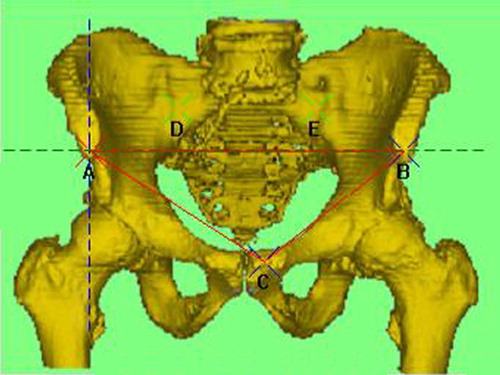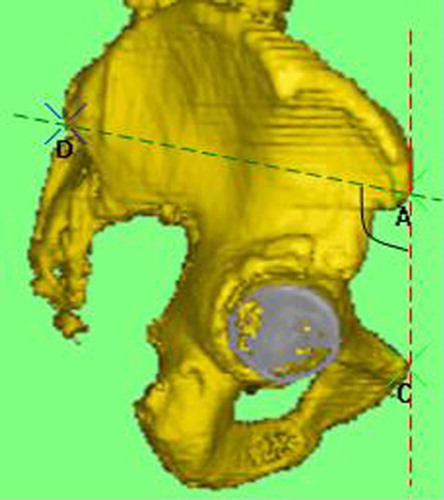Figures & data
Figure 1. Anteroposterior view showing the anterior pelvic plane (plane ABC or APPCor, shown in green); planes APPSag and APPAx are represented by the blue and green dashed lines respectively.

Figure 2. Cephalocaudal view showing the transverse pelvic plane (ADE or TPPAx, shown in green); planes TPPSag and TPPCor are represented by the blue and red dashed lines respectively.

Figure 3. Right lateral view showing the angle between planes TPPAx (green) and APPCor (red); points A and D are overlapping with points B and E, respectively.

Figure 4. Cephalocaudal view showing the relationship between the plane of the acetabulum and plane APPAX; line FG is formed by the intersection of the two planes, and the angle between this line and plane APPSag (blue dashed line) is the anteversion relative to the APP coordinate system (AVAPP). [Color version available online.]
![Figure 4. Cephalocaudal view showing the relationship between the plane of the acetabulum and plane APPAX; line FG is formed by the intersection of the two planes, and the angle between this line and plane APPSag (blue dashed line) is the anteversion relative to the APP coordinate system (AVAPP). [Color version available online.]](/cms/asset/d7e17038-d931-4b23-9a60-5fe34ba6b37f/icsu_a_209014_f0004_b.jpg)
Figure 5. Cephalocaudal view showing the relationship between the plane of the acetabulum and plane TPPAx; line HI is formed by the intersection of the two planes, and the angle between this line and plane TPPSag is the anteversion relative to the TPP coordinate system (AVTPP). [Color version available online.]
![Figure 5. Cephalocaudal view showing the relationship between the plane of the acetabulum and plane TPPAx; line HI is formed by the intersection of the two planes, and the angle between this line and plane TPPSag is the anteversion relative to the TPP coordinate system (AVTPP). [Color version available online.]](/cms/asset/047f7a34-63ba-4f7a-8dc4-5a0e179518e1/icsu_a_209014_f0005_b.jpg)
Table I. Acetabular anteversion (AV) and inclination (Inc) in relation to the APP and TPP coordinate systems.
Table II. Reliability correlations for the APP and TPP coordinate systems. (AV = anteversion; Inc = inclination)
![Figure 6. Scatter diagram showing the average anteversion (AVAPP) and inclination (IncAPP) angles for the 34 hips relative to the APP. The “safe zone” of Lewinnek is also shown (dashed lines). [Color version available online.]](/cms/asset/f930dec9-c5ba-4fe7-89df-992fc2c3dd21/icsu_a_209014_f0006_b.jpg)